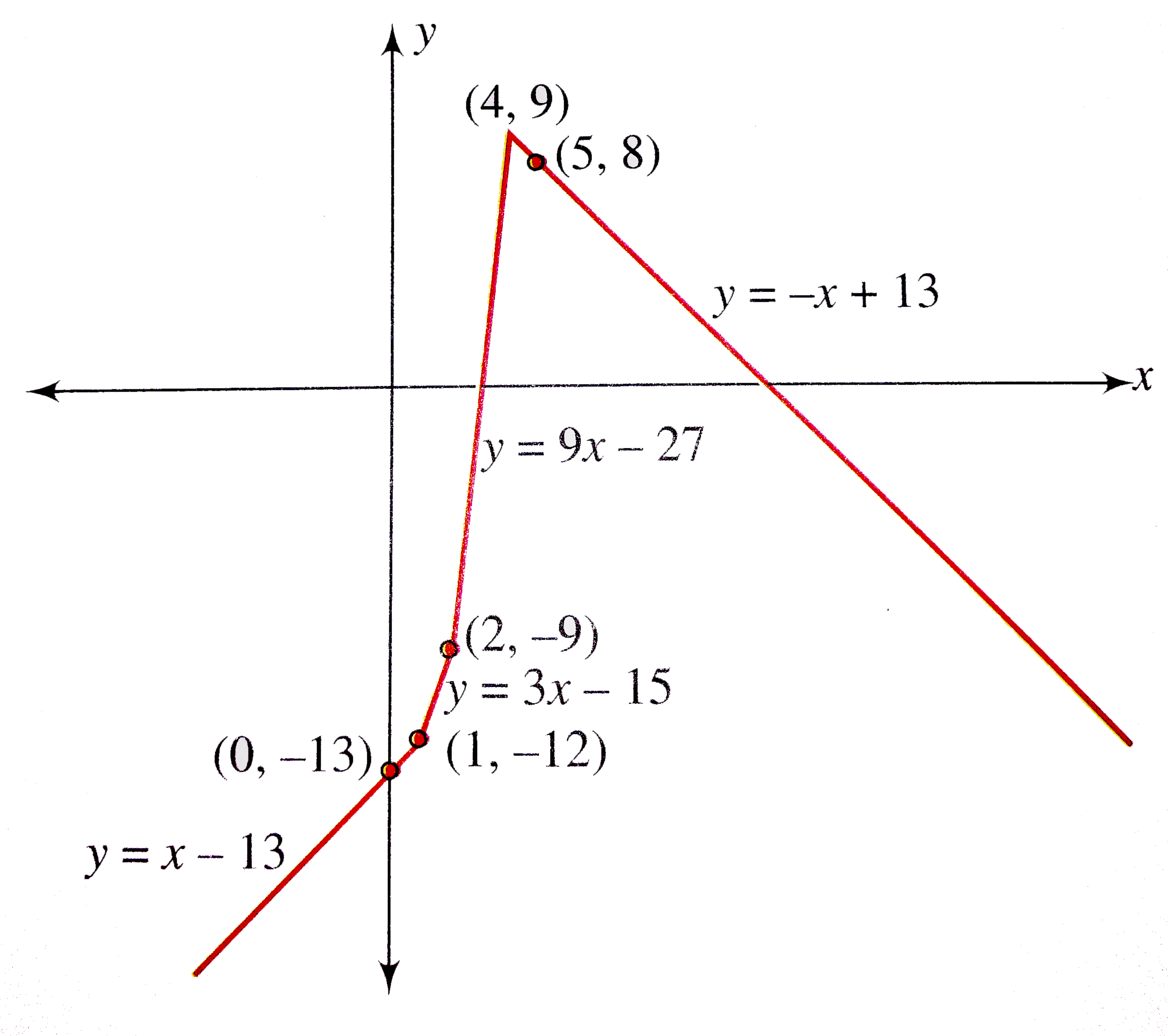Draw the graph of f(x)=y=|x−1|+3|x−2|−5|x−4| and find the values of λ for which the equation f(x)=λ has roots of opposite sign. Solution in Bengali
We have y=f(x)=|x−1|+3|x−2|−5|x−4|
=⎧⎪
⎪
⎪
⎪⎨⎪
⎪
⎪
⎪⎩1−x+6−3x−20+5x,x<1x−1+6−3x−20+5x,1≤x≤2x−1+3x−6−20+5x,2<x<4x−1+3x−6+20−5x,x≥4
=⎧⎪
⎪
⎪
⎪⎨⎪
⎪
⎪
⎪⎩−13+x,x<1−15+3x,1≤x≤2−27+9x,2<x<413−x,x≥4
Graph of the function is as shown in the following figure.

Topper's Solved these Questions
- GRAPHS OF ELEMENTARY FUNCTIONS BOOK - CENGAGE PUBLICATIONCHAPTER - GRAPHS OF ELEMENTARY FUNCTIONS EXERCISE - EXERCISES
34 Videos
- GRAPHS OF POLYNOMIAL AND RATIONAL FUNCTIONSBOOK - CENGAGE PUBLICATIONCHAPTER - GRAPHS OF POLYNOMIAL AND RATIONAL FUNCTIONSEXERCISE - Exercises
17 Videos
- GRAPHS OF TRIGONOMETRIC FUNCTIONSBOOK - CENGAGE PUBLICATIONCHAPTER - GRAPHS OF TRIGONOMETRIC FUNCTIONSEXERCISE - Exercises
22 Videos
Similar Questions
Draw the graph of y=1(1/x).
View SolutionDraw the graph of y=(x−1)(x2−x+1).
View SolutionDraw the graph of y= cosec 2x−cot2x. Is f(x) periodic ? If yes, what is its fundamental period ?
View SolutionIf f(2−x)=f(2+x) and f(7−x)=f(7+x) and f(0)=0. If the minimum number of roots of f(x)=0 where 0≤x≤100 is λ then λ/3 equals
View SolutionDraw the graph of y=|x−1|+3|x−2|−5|x−4| and find the values of λ for which the equation f(x)=λ has roots of opposite sign.
View SolutionIf f(x) and g(x) are continuous functions, then ∫In(1/λ)Inλf(x2/4)[f(x)−f(−x)]g(x2/4)[g(x)+g(−x)]dx is
View SolutionIf f(x)=∣∣ ∣∣x+λxxxx+λxxxx+λ∣∣ ∣∣, then f(3x)−f(x)=
View SolutionIf the equation x2+2(λ+1)x+λ2+λ+7=0 has only negative roots, then the least value of λ equals______.
View SolutionLet f(x,y)=0 be the equation of a circle. If f(0,λ)=0 has equal roots λ=1,1andf(λ,0)=0 has roots λ=12,2, then the centre of the circle is
View SolutionThe values of λ for which the system of equations x+y−3=0,(1+λ)x+(2+λ)y−8=0,x−(1+λ)y+(2+λ)=0 is consistent are
View SolutionLet f(x,y)=0 be the equation of a circle. If f(0,λ)=0 has equal roots λ=1,1andf(λ,0)=0 has roots λ=15,5, then the radius of the circle is
View SolutionThe values of λ for which the system of equations
x+y−3=0
(1+λ)x+(2+λ)y−8=0
x−(1+λ)y+(2+λ)=0
has a non trivial solution are
View SolutionDraw the graph of f(x)=y=|x−1|+3|x−2|−5|x−4| and find the values of λ for which the equation f(x)=λ has roots of opposite sign.
View SolutionIf f(x) and g(x) are continuous functions, then ∫In(1/λ)Inλf(x2/4)[f(x)−f(−x)]g(x2/4)[g(x)+g(−x)]dx is
View SolutionLet f(x,y) =0 be the equation of a circle. If f (0, lamda)=0 has equal roots lamda=1,1 and f (lamda, 0 ) =0 has roots lamda =1/2 ,2, then the centre of the circle is
View SolutionLet f(x,y)=0 be the equation of a circle. If f(0,λ)=0 has equal roots λ=2,2andf(λ,0)=0 has roots λ=45,5 then the centre of the circle is
View Solution
